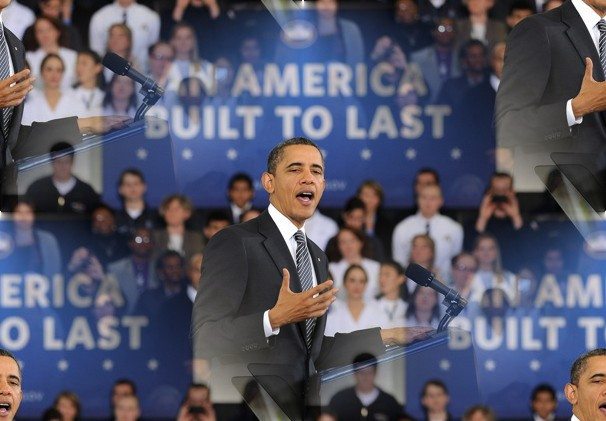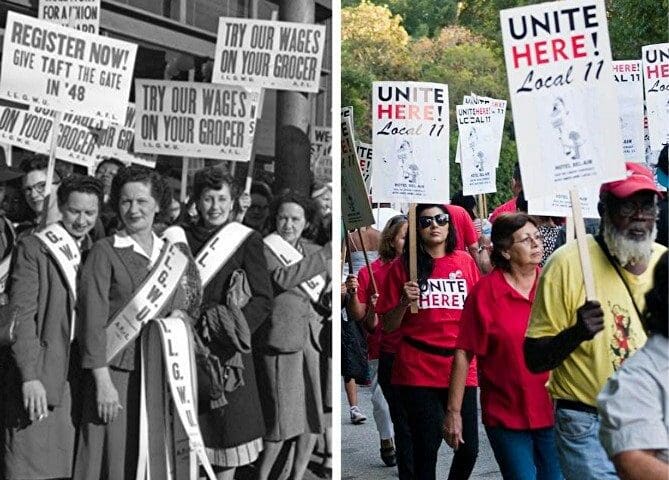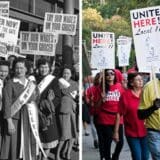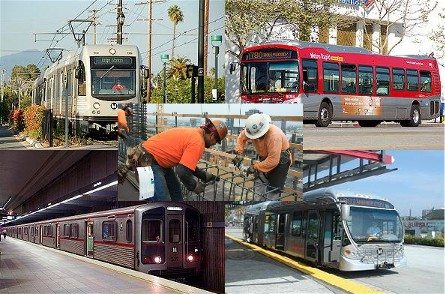

The U.S. Supreme Court’s recent decision declining to hear an appeal of the L.A. Grocery Worker Retention Ordinance sparked protests from the California Grocers Association. The CGA claimed that the ordinance, which protects the jobs of grocery employees following an ownership change, will do more harm than good in communities suffering from lack of access to healthy food options. Dave Heylen, speaking to the L.A. Business Journal on behalf of the CGA, had this to say: “Our industry and community health groups have long been working to bring more stores into these underserved areas.”
Since when?
For decades, as grocery stores fled South and East Los Angeles, community groups demanded answers from the industry, only to hear the same refrain over and over again. “It’s too difficult to operate in poor neighborhoods.” “Costs are too high.” The Los Angeles Community Redevelopment Agency,
» Read more about: Grocers Association Fights Food Deserts! Really? »


(Note: Brian Beutler’s post first appeared on Talking Points Memo. Frying Pan News presents it here as a snapshot of the Congressional fight over the future of America’s social safety net and does not intend it to be an endorsement of one political party or criticism of another.)
The GOP’s accession to reality on the payroll tax cut is being cast as a key victory for Democrats and President Obama. Republicans caved, the payroll tax will almost certainly be renewed, and the economy won’t take a tough hit just as the recovery’s beginning to accelerate.
But it also reveals a flaw — a potentially huge flaw — in the conservative movement’s generational strategy to roll back the federal safety net.
These might sound like two wildly disparate issues, but they’re actually variations on a years-long theme.
» Read more about: Payroll Tax Cut to Extend; Entitlement Fights Loom »


(Note: This January 27 post by David Madland and Nick Bunker appeared on the Center for American Progress’ Action Fund blog.)
The Bureau of Labor Statistics, or BLS, data released today on the union status of the American workforce in 2011 show no growth in union membership—a troubling sign as the nation debates how to strengthen the middle class. That’s because unions help strengthen the middle class by giving workers a voice in the economy and our democracy. Yet the fact that union membership didn’t significantly decline—even amid a weak economy and harsh political opposition—is a significant accomplishment and offers some hope for the future.
Overall, the BLS figures show that the union membership rate fell from 11.9 percent in 2010 to 11.8 percent in 2011, but the difference is so small that the rate effectively stayed the same.
» Read more about: Unions Are the Foundation of America's Middle Class »


We know it’s last-minute, but for those wishing to celebrate Valentine’s Day with a tip of the hat to labor, the folks at L.A. Labor 411 have a list of businesses you may be in need of February 14 that proudly fly the union label. The following are a representative sampling from some select categories.
Ghirardelli Chocolates
Hershey Chocolate
Hershey Kisses
Russell Stover Candy
See’s Candies
Godiva Chocolates
Albertsons
El Super
Gelson’s
Ralphs
Stater Bros.
Vons
United States Postal Service
UPS
Encounter Restaurant LAX
La Scala
Musso & Frank Grill
Beverly Hilton
Doubletree San Pedro
Fairmont Miramar
Renaissance Hollywood
Sheraton Universal
Westin Bonaventure


“Creative destruction” has been widely invoked again since Newt Gingrich began attacking Mitt Romney’s record at the private-equity firm, Bain Capital. Of course, the term is a perennial favorite with business writers. But in response to Gingrich’s attacks, Romney and his allies have insisted that Bain exemplifies “creative destruction,” the closely-linked glory and pain of unfettered capitalism.
“Creative destruction,” the concept, however, carries a more mixed message than many of Romney’s defenders may think. In fact, it points to deep problems that face conservatives whenever they argue that ordinary people should look past the ugly and brutal side of economic life. The phrase was first used by the Austrian economist, Joseph Schumpeter, in his 1942 book, Capitalism, Socialism and Democracy. It referred to a phenomenon Schumpeter had been writing about for decades, a process bound up with entrepreneurship and innovation.
Entrepreneurs, Schumpeter argued, were no ordinary businesspeople. Entrepreneurs were visionaries,
» Read more about: Romney's Resume: Who’s Creative? Whose Destruction? »


It seems inevitable that national coverage of the Occupy movement has been dying down. The sporadic stories I read are of arrests of occupiers in different cities, but I surmise that this too will eventually become old hat in the media and we will soon settle our attentions wholeheartedly on the presidential election, which in my opinion is a real shame.
I’ve grown weary of our gerrymandered elections. For a country that holds freedom of choice so dear to American life, I find it odd and disheartening that we are really only given two parties to choose from. The consumer in me gets depressed every election cycle. It’s akin to going to Ben and Jerry’s and being told that you can only have chocolate or vanilla.
My sincere hope is that this year the narrative is different. I am pinning my hopes on the Occupy movement to resurrect itself to the national news media and overshadow our fixed-choice election for the presidency.


(This post originally appeared February 8 on the author’s Switchboard blog.)
Yesterday, the Bureau of Sanitation for the City of L.A. released its recommendations for fixing the inefficiencies in L.A.’s waste system. After more than a year of careful consideration, the Bureau determined that an exclusive franchise system with 11 franchise zones for the commercial and multi-family sectors would provide the best solution to increasing recycling and minimizing the burden that waste collection imposes on L.A. residents.
As I have written before, the commercial and multi-family sectors are responsible for approximately 70 percent of the waste L.A. sends to landfills, so it is an important nut to crack to meet the City’s zero waste goals. I have written several blogs on this issue and on the benefits of going to zero waste ranging from reducing our dependence on polluting and space hogging landfills to reducing our greenhouse gas emissions to creating more jobs.
» Read more about: Big Step Taken to Resolve LA's Trash Crisis »


(This post first appeared as a Los Angeles Times opinion piece.)
Last week, one of the country’s oldest and largest public economic development programs came to an inglorious end when the governor and Legislature pulled the plug on California’s 400 redevelopment agencies.
So why did the governor and lawmakers end the state’s only real community revitalization program, especially at a time when there is such great need for jobs and affordable housing?
The biggest reason was the desire of local governments and the state to use the programs’ resources — about $6 billion a year statewide — to fill budget holes. But part of the fault also lies with the agencies, which never fully articulated a mission or resolved tensions between public purpose and private profit.
The purpose of redevelopment, laid out in the original law authorizing it, was to “eliminate physical blight,”
» Read more about: California Needs a Redevelopment Reboot »


By Maria Elena Durazo and Denny Zane
(This feature first appeared on the Huffington Post.)
While Washington, D.C. has been stuck in what amounts to a partisan traffic jam on the 405 at rush hour, unresponsive and unwilling to rebuild our national economy and infrastructure, we took matters into our own hands in Los Angeles.
In November of 2008 business, labor and environmental organizations of Los Angeles County worked together to sponsor Measure R, a half-cent sales tax increase to fund transportation projects throughout the county. When voters overwhelmingly approved Measure R, they may have been looking primarily for solutions to traffic congestion and air pollution, but they succeeded in approving nearly $40 billion over 30 years to create hundreds of thousands of jobs as well as an economic stimulus for Los Angeles.
In addition, Mayor Villaraigosa is working hard to convince the federal government to create a program of low-interest financing for Measure R’s transit program to accelerate the implementation of those projects over 10 years,
» Read more about: “R” Is for Recovery: 23,400 Jobs Coming to LA Metro »


It’s not known if the Tea Party will ever be identified by one color, the way our two dominant political parties are. With red and blue already taken, it’s tempting to guess that the Tea Party would embrace – well, white. In any case, it won’t be green. Consider a February 4 New York Times piece, which spells out the tireless campaign waged by the movement against any legislation tilting toward a sustainable environment. Some of the laws vehemently contested include:
The reason for Tea Party opposition to these seemingly uncontroversial undertakings is a deep suspicion of an obscure and nonbinding United Nations resolution passed in 1992.
» Read more about: Tea’d Off! Why the Baggers’ Grassroots Aren’t Green »